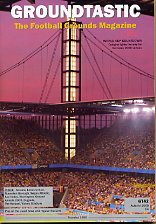I watch a lot of YouTube videos in bed at night in an attempt to lull myself to sleep. I have mixed results with this tactic. It sometimes works if I am in the mood to listen to some soft rock, but most of the time I opt for punk rock bands of the 70’s or Britpop anthems from the 90’s. These tracks only serve to energise me, but last night I found myself having to make the conscious decision to turn off my tv in the wee small hours of the morning. I had been watching the vlogs of Footy Adventures, which I would heartily recommend to those of you who are interested in football stadiums and architecture.
These vlogs reminded me of a series of articles that I was sharing with my blog readers, back in 2015/16.
Between 2002-2008 I was Scottish Correspondent for the wonderfully professional Groundtastic – The Football Grounds Magazine. I can not speak highly enough of the editors and contributors to this glossy magazine that is jam-packed with interesting information and photographic gold.
I haven’t been a subscriber to the magazine since my marriage imploded in 2008 and I was forced to leave Scotland. Since then my dexterity has deteriorated to such an extent that I now find it impossible to simply thumb through a magazine.
Imagine my excitement then when I visited the Groundtastic website to discover that they now have a digital edition available I’ll definitely be subscribing.
Anyway, over the next few months I will be sharing a number of articles that I penned during my time North of the Border, including my regular Scots Scene news round-up of potential football ground developments and improvements. The following is from Autumn 2005, and it will be evident to ground enthusiasts and football fans just how much has changed from the era in which it was written…
Enjoy a short step back in time.
***

ABERDEEN’S proposal to build a 20,000-seater stadium in the city’s King’s Links area has been rejected by the local council. The stadium proposal formed part of a £60m project to overhaul the city’s beachfront into a sporting centre. Despite this, concerns were raised at the council meeting that the plan could jeopardise proposals for a regional sports facility and may have a detrimental impact on the local golfing community. It was also claimed that residents in the surrounding Seaton and Linksfield areas had not been properly consulted and the council voted 29-8 to reject the application. A club spokesman said: “This was always going to be a long-term vision and things like this will inevitably go through many obstacles along the way. While the reaction’s a disappointment, it’s something that has to be expected with something of this magnitude.”
However, it was not all bad news for the Dons as councillors backed a separate application to build a £23m sporting centre of excellence at Aberdeen’s Chris Anderson Stadium.
In May, the SPL board voted to outlaw the synthetic surface that DUNFERMLINE had installed in March for use this season. A statement from the SPL revealed that the decision was a unanimous one but said they would work with UEFA and FIFA to develop future artificial pitches. This meant the Pars – who are £7m in debt – would have to replace the East End Park pitch with natural grass at a cost of £500,000.
However, Dunfermline weren’t going to roll over without a fight and lodged an appeal with the SFA. Hopes were raised when the SFA voted 73-7 to approve the use of FIFA-approved artificial surfaces in its leagues. Days later, the SFA decided that the SPL should hear Dunfermline’s case again.
On July 11, after a five-hour meeting at Hampden the board stuck to their original decision with the Pars determined to battle for compensation. Dunfermline chairman John Yorkston said: “They rejected our application because the pitch hasn’t reached FIFA two-star status, but it has passed all the tests apart from being subjected to 3000 hours of sunlight [unlikely in West Fife] and that will have happened by September. We offered to put down a surface that does have two-star status and they also rejected that because it would not be ready for the start of the season.”
Subsequently, Dunfermline has started ripping up their artificial surface – to be replaced with the grass originally intended for Wembley Stadium. It is similar to turf used by Manchester United, Bolton Wanderers and Sunderland.
Meanwhile, several Scottish Football League clubs are interested in buying the artificial pitch from Dunfermline.
FALKIRK has started work on a new Bistro on the third floor of the Falkirk Stadium’s Main Stand. The facilities are owned, financed and operated by MAAD Operators Limited – a company specially formed by local business people with strong connections with the club. MAAD in conjunction with Drew Norloch, the current supplier of all catering at The Falkirk Stadium, will manage the daily operation of the facility. The Bar Bistro, still to be named, will be open seven days a week to everyone, but during match days it will restrict entry to members and hospitality guests. The Bistro will have two bars, plasma TV’s and will serve morning coffee, lunches and evening meals. A target opening date has been set as 1 October 2005.
Meanwhile, Falkirk has also announced a two-year sponsorship deal with Kier Homes for their new North Stand. The company will also sponsor the home & away dug-outs, season tickets and provide 1000 footballs to the Falkirk School of Football to help in the development of youth football in the area. The Kier Homes name and logo will extensively appear throughout the new North Stand, the dug-out areas and the match day interview board for all TV interviews
However, not everything is running smoothly at the Falkirk Stadium. On the eve of the new SPL season, it was claimed that Falkirk’s pitch could give off electric shocks because the undersoil heating is faulty. Heating specialists TES claims someone could be injured if a fork is driven too hard into the turf and that the system does not even have the power to thaw Falkirk’s pitch in freezing weather. Engineer Paul Metcalf has declared the job “unfinished” and is refusing to accept liability for any accidents that happen. He wants the pitch to be ripped up and the current system taken out to be replaced with a safe one – a job he estimates would cost £500,000. Mr Metcalf said: “This pitch is not safe and everyone knows it – people are just not prepared to pay the money to have it done properly,” Construction giants Mowlem, which built the Falkirk Stadium, had a state-of-the-art system supplied by top firm Inditherm – but the undersoil heating failed its first test against the big freeze when the pitch failed to thaw before a crunch match against Clyde. Inditherm insisted Mr Metcalf’s claims were unfounded and the result of a vendetta over a legal battle between it and TES. The stadium’s owners insist they are happy with the pitch and have had t cleared by the local authority and the SPL.
HEARTS have spent the summer improving Tynecastle to make it compliant with UEFA standards. A row of seats has been removed from both the Roseburn and Georgie stands to allow the pitch dimensions to be extended to meet UEFA’s minimum criteria of 100 metres x 64 metres. 280 seats have been removed to achieve this. Tynecastle’s reduced capacity is now around the 17,400 mark. Hearts had asked the SFA if they could postpone the improvements as they failed to qualify for this season’s UEFA Cup but this request was rejected. The work was carried out as part of the SFA’s National Club Licensing audit and cost around £65,000. Internal work was also carried out, with the dated referees’ room being upgraded to meet further requirements of the National Club License.
ST MIRREN has been given the green light to sell its Love Street ground to a supermarket chain – a decision that secures the future of the club. After lobbying from supporters, Renfrewshire Council agreed the Buddies could sell to a retail outfit – guaranteeing them £10m – which will clear the clubs debts of over £2m and allow them to build a new stadium at Greenhill Road in North Paisley. Buddies chairman Stewart Gilmour was delighted: “The ground will definitely be sold but that was always going to be the case one way or the other. But it will now be sold to a retail operator, which will allow us to build a SPL compliant stadium at Greenhill Road. It will be a modern stadium with modern facilities and 5-a-side pitches which will bring in income streams out with the football club. I think the whole process will happen between the next 18 to 24 months. We’ll remain at Love Street for now, but I’ve got to admit that it will be a sad day when we finally have to leave it,” said Gilmour.
After many months of using Livingston’s Almondvale, the SCOTTISH WOMEN’S NATIONAL TEAM will now use McDiarmid Park – home of St Johnstone – as their official base.

